I’m baffled by why my door is NOT a weak point. The interior face of the door measures a few degrees cooler than the air temp in the room, and within a half degree or so of the heavily insulated adjacent walls. I assumed I’d have to leave a second door in place outside the door to the room, or insulate the back of the door the way you have, but at this point, I think it will be fine. And I can’t imagine that it’s better than R-7 because it’s just a standard ~1 1/4" insulated exterior door. ![]()
![]()
An update. After several days circa 90F outside, with overnight lows circa 70F, the rest of the basement is in the mid 70Fs. The wine room air temp is up to 65F a couple of feet off the floor.
The first surprise is the door, which can’t be more than R-7 or so. As these photos show, it’s only a half degree warmer than the adjacent wall, which is R-34. (The red dot is the laser light indicating the center of the narrow cone read by the infrared temp gun.)
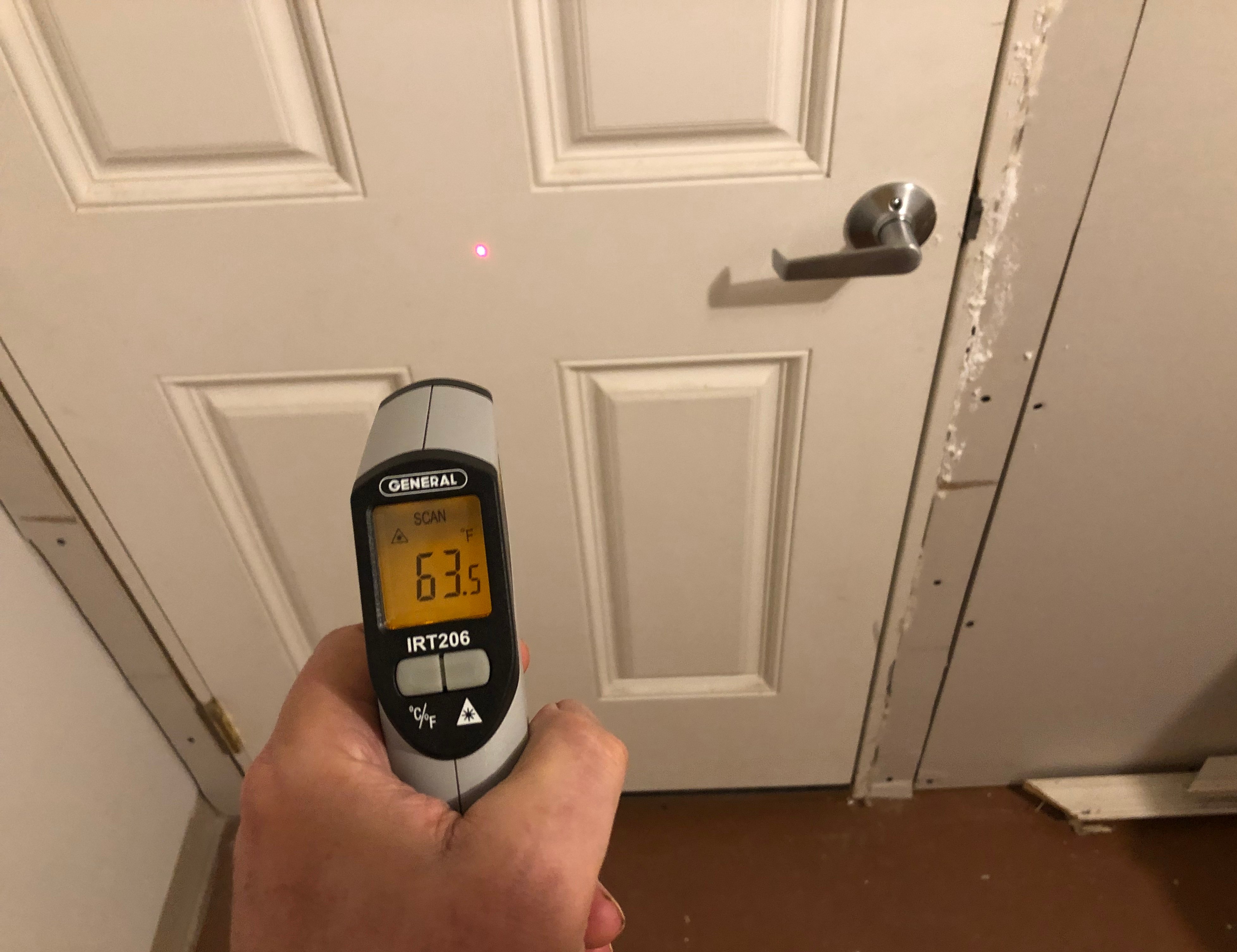
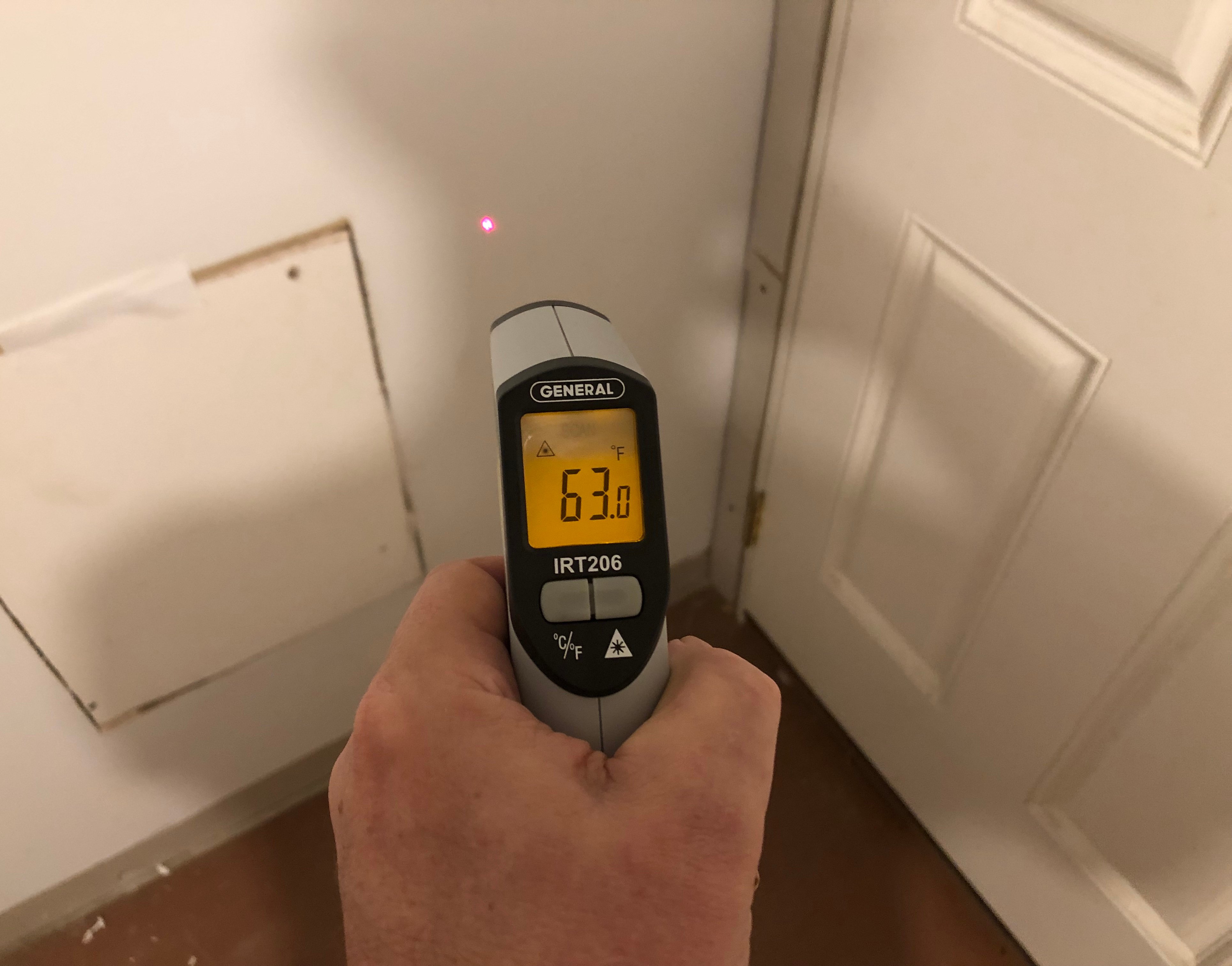
The other surprise is the ceiling, which has R-43 insulation, yet it’s reading 64F (see below). I assume that reflects the warmest air in the room, and isn’t because of heat coming in from the outside.
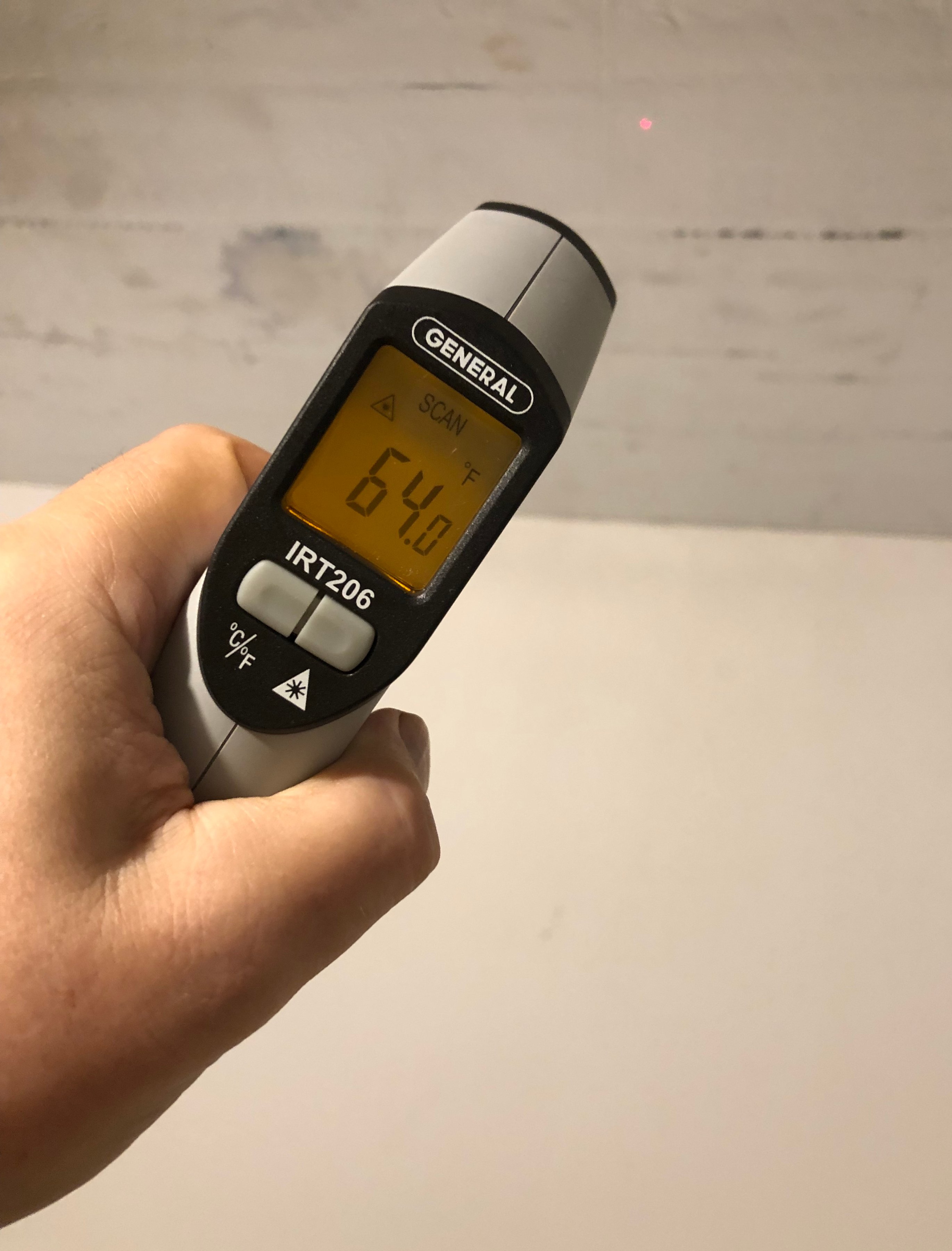
The floor temperature varies quite a bit from the northwest corner of the house, roughly 6 feet below grade, to the area around the door, which receives heat from the rest of the basement through the concrete on two sides (first two photos below). The third photo shows the floor temp just outside the door: 66.5F.
These are all substantially higher than they were ten days ago. I’m not sure if that’s because the ground has warmed up, or because there’s some heat penetrating the other surfaces notwithstanding the insulation and that’s warming up the surfaces. Maybe a combination of both.
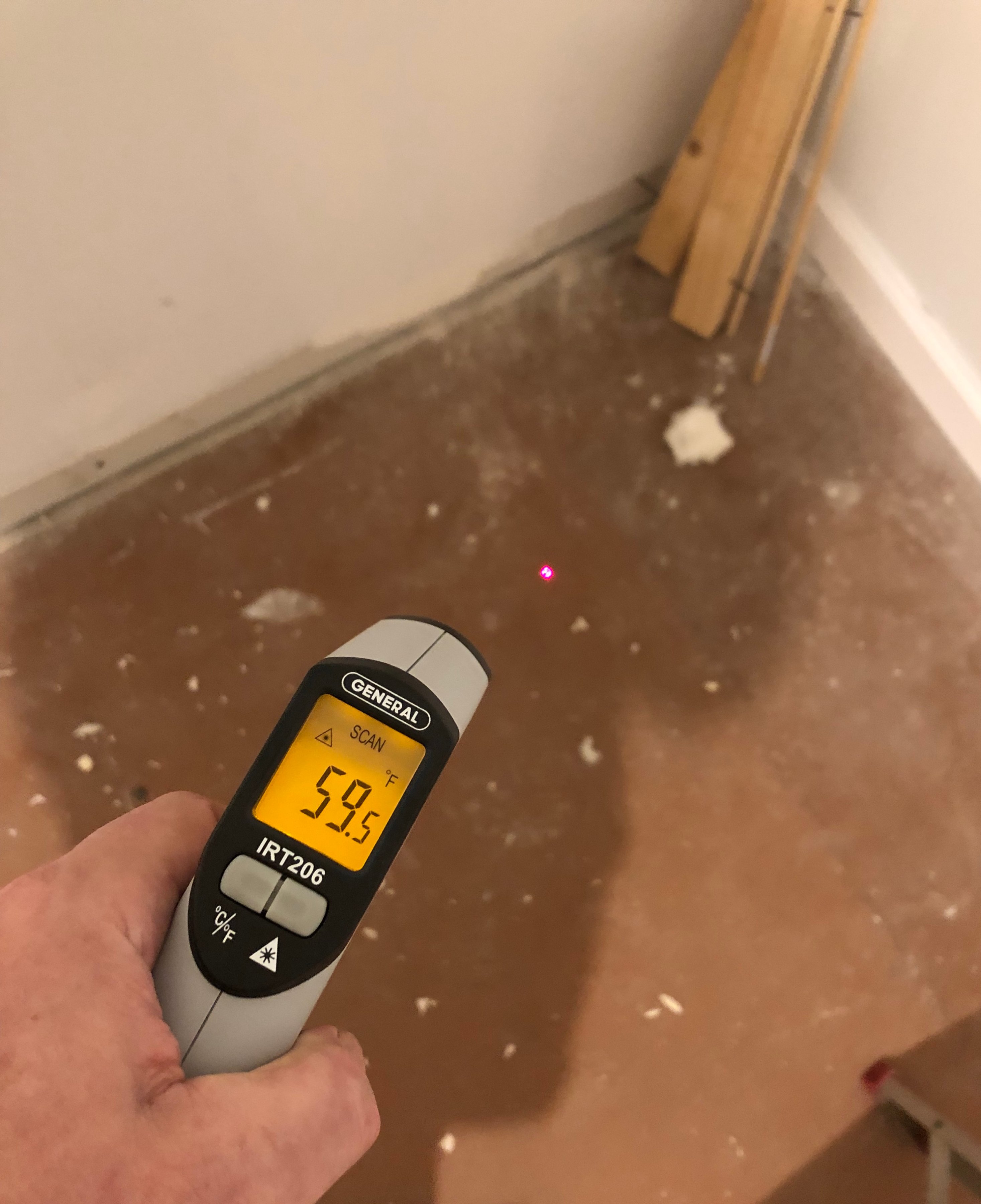

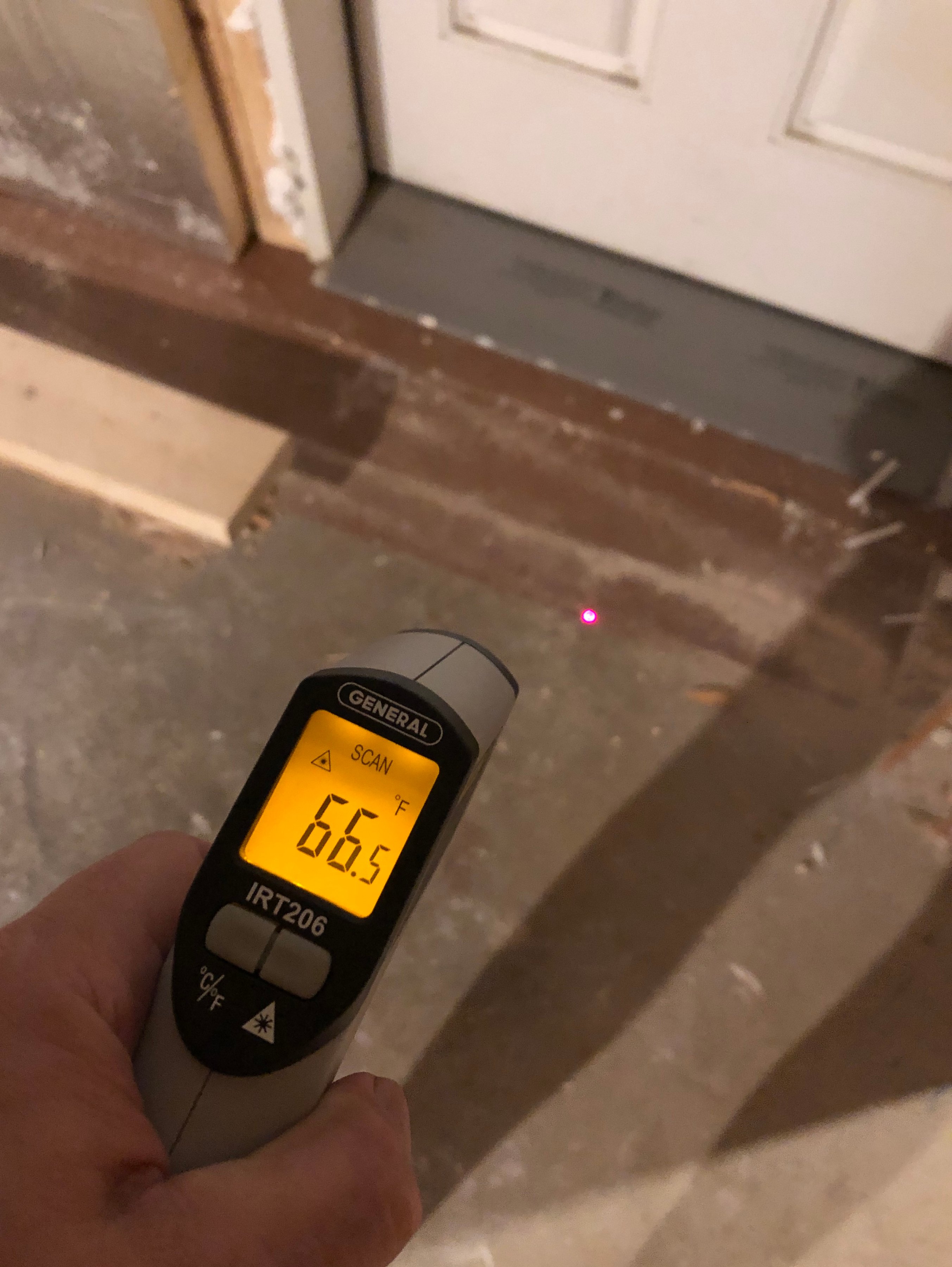
Bottom line: At this time of year, the subgrade floor isn’t cool enough to bring the air temp down as much as I’d like, but I can life with 65F.
This is probably one of the culprits, 15" to 18" of west-facing foundation wall that’s above ground. It’s measuring 78.5F when the sun is behind the clouds.
So far as I can tell, there’s only R-10 insulation on the inside, so this is likely transmitting heat into the room. Inside, that surface is up around 63F or 64F, the warmest point on the walls.
I’m thinking of digging down along the wall and inserting some R-13 insulation board below the surface and along this exposed portion, then building a planter along the outside to hide the insulation and protect the wall from direct sun.

That should solve your problem 
If nothing else, the passive cellar project does lead to some interesting/fun sleuthing to determine where the hot spots are coming from!
Still in search of that elusive Passive Wine Cellar!! An update.
Finally had a chance to frame in the wine cellar and after what seemed like an odyssey to hire somebody, I had it close foam sprayed. (Picture link below)
Roof is 5.5" of foam or about R-36 value. Walls are 3.5" of foam for about R-23 value. Since I had it done at the begining of July, the room was mid 70’s when it was finally sprayed. After curing, I moved my workshop portable AC into the room to cool it down. Mainly targeting the cement floor to get it cooled…which might have been a fallacy on my part. The portable AC was set at 65. I let it run for about a week. Cement floor slab read on the infared 63 when all done.
Since I have removed the AC unit and kept door shut, the temperature of room has moved up and stabized at 72 degrees with humind at 70%. This has been last seven days.
Am I doomed that this is not going to be a passive wine celler?
Or do I need to give it more time for the cement floor to chill to the ground temperature since it is 10 feet underground on 3 sides?
Note the 1 wall facing the rest of the basement is unfinished, However, I am assuming the wall at R23 with spray foam solidly around the door on both sides and a solid sealed door should not be disrupting things that much. Rest of basements unfinished area is around mid 70’s.
Thanks for any thoughts.
I live in Chapel Hill and have done quite a few cellars. Unfortunately going passive here in NC is a dream. The good news is you have the correct setup to add cooling now. I did the exact same thing all closed cell and put in a mini split cooler which has worked great. You may be able to keep it under 68 in the summer which is not cool enough for my needs but YMMV.
He is correct. And you have a good set up to go with a small amount of cooling and probably be passive 2/3 of the year.
Hello everyone. My name is Jonathan and I’m new to the wine berserkers community. I thought I’d revise this thread since I am in a similar situation to people that have posted above. Thank you for all the wonderfully useful information.
I have been collecting wine for only a short time during trips to Italy, Spain, California, Oregon and my local wine shops. Only recently have I discovered the world of online wine shopping. You can see my progress in CT, handle is the same as my username here.
I moved into a home a couple years ago that looked to have a great cellar area; three concrete walls 90% sub-grade, concrete floor with the 4th wall and door that leads to our finished basement. My father (who is also a huge oenophile) helped me build some wine racks from old fence boards during Christmas after we moved in. I have since added more as the collection is growing. I’ve been monitoring temperature and humidity for a couple years and seems to be excellent except for the last couple months of summer. I live just outside Denver, CO at 6000 ft. Very similar to the other gentleman posting here. Humidity here is always between 10-30%, so I added a small humidifier and wicking water bucket and can get to the 60’s. Temperature is usually perfect for 2/3’s of the year sitting in the mid 50’s. It creeps up to mid to high 60’s during July, August and sept. Very very little daily temp swing. I also have the infrared thermometer (originally for cooking…everyone should have one!) and it’s never read over 68°.
I am currently reading Dr. Gold’s book as suggested here. Looks like I need more insulation and a vapor barrier. Any other advice is always appreciated. Thanks again!
Ps, tried to include a picture but couldn’t get it to work from my phone. Although only 34 years old, I feel like I am technologically challenged haha
Not too different from my experience, though my wine room maxed out around 66 during the hottest weeks in July and August. Since early September it has drifted down to 63, with little bumps when we’ve had a couple of consecutive hot days. This is in the Catskills at 800 feet elevation, so it stays in the 60s at night on all but a few summer nights. Hence, it’s stayed cooler than yours in North Carolina!
As I said above, based on the Gold Bible and my temperature gun readings, I think when part of your foundation walls are above grade and the rest of the basement is warmer (low to mid-70s max in my case), there’s going to be a lot of heat being transmitted through the concrete floors and walls. Unless you have a big room with a large floor area to act as a cooling surface, the temp is going to be closer to the walls and ceiling than it is to the floor. From your photo, your room looks smaller than mine, so you have a pretty small cool floor to try to compensate for heat coming through the other surfaces.
Your temps are very similar to mine.
What insulation do you have?
Looks like ineffective standard 3.5” Batt.
I haven’t gotten to the meat of the book yet but from these forums I surmise I’ll need better insulation, moisture barrier and a much better door. My goal is to have passive temp control and only minimal intervention to retain higher humidity. And buy nice wine until it’s full and the wife is furious. ![]()
Is air flow really that important? How much flow can happen in subterranean caves that we are modeling after?
That isn’t a lot of insulation. What’s that - R-14?
But the real issue is the ratio of your floor to the other surfaces. Even with more insulation, eventually the walls and ceiling will approach the temps of the outer areas/ground they face unless the space is cooled by the floor. And the smaller the room, the worse the ratio of cool floor to other surfaces.
In that small space, even if you insulate out the wazoo, I doubt that the temperature will come down. As I’ve explained above, near the basement-facing walls, the floor will approach the temp of the rest of the basement. It’s a mistake to assume (as I did when I moved a wall in because I didn’t need so much space) that the floor temp will more or less equal the ground temp below. Heat travels laterally through the floor from the rest of the basement. My room is big enough that the parts around the exterior walls are cooler than the areas near the basement-facing walls, so the floor has some cooling effect (though not enough to keep it in the low 60s).
But your room is so small that I’d guess your floor temperature inside the wine room isn’t too different from the floor temp in the rest of the basement. Luckily, you’re in a climate where the room still gets no warmer than 68. From those pix, I doubt you can get the peaks to stay much below that.
I had a passive cellar at 8k elevation in CO for many years. It was well insulated (batting not foamed) and with a proper vapor barrier. It reached the lower 60s in peak summer heat. So that is probably a little better than one can do down in the flatlands with a perfect setup. I did eventually put in a split system which may have been overkill but I had a bunch of very nice wines that deserved it. It was fairly inexpensive to do actually.
It you want to improve what you have putting in closed cell insulation on the walls and ceiling (not floor) is what you can do to help things. That will give you a good R value and provide a vapor barrier. Plus if you ever add cooling you’ll be all setup for that as well.
I also had to add moisture with an evaporative humidifier. A basic vornado evaporative humidifier does a good job. You need to change the wicks once they get full of deposits.
Welcome to the forum (from someone who has not been around too long either…)!
By the way: you mentioned looking at your CT profile, so I did. Not sure if it is intentional or not, but looks like your CT Cellar is locked, so people cannot see it. No worries at all if you want it that way, but thought I would mention it since you invited folks to view.
Looking at your pictures, I would agree, more insulation and a vapor barrier should help.
Question for those using a humidifier: do you worry that the humidifier itself gives off heat? Even if it is a small amount, if it is on for days and days, I would think it could alter the temp of the room? (I live in the humid northeast, so not a concern for me, but just curious.)
Mark, an evaporative humidifier does not add heat and actually cools a tiny bit. Just like a swamp cooler in principle. But I just assume no added heat in a passive cellar. If active any style humidifier is fine. Keep 8n mind adding moisture is not generally needed. In NC I need to remove humidity.
Any concerns of mold/mildew accumulating?
I’m currently using a closet underneath my staircase in my finished basement and ended up putting 2 vents that vent in/out to the laundry room which houses the water heater and the water pump. One vent is located at the base and the other towards the top. My intention was for air to somewhat cycle through. During the warm northwest CT months, the temps max out at around 65 degrees with a relative humidity of around 60%. Not ideal but also not bad.
I think 65 is ok for a few months every year.
Mold in my experience does not start until the relative humidity is 75% and higher. I would target 70% in COand never any mold. Here in NC I have seen a bit but the cellar has gotten over 80% occasionally in the summer. So bingo. And of course mold poses no issues for the wine, just labels and resale value.
Mark, I have changed my CT settings and should be available for general viewing. Nothing too fancy in there yet, but respectable 200 bottle collection. My small humidifier does not seem to raise the temp of the cellar at all. I run it on a timer, 3 hours on then about 6 hours off. Only pain is having to fill the water tank about every 36-48 hours. My hope is that a tight vapor barrier will retain moisture longer so I can run the humidifier significantly less and not have to fill it every 2 days. Not worried about mold in Colorado, I can barely keep it at 60-65%.
John, you are correct. I checked the rest of my basement and it was also 68 degrees. The cellar is pretty small; I just felt lucky to have it in our house. My racks, although fun to build with my dad, are incredibly inefficient for storing large quantities of wine. I can probably get another 200 bottles in there. If I get to 500+, I would probably look at expanding the cellar and incorporating a cooling unit but trying to stay close to passive for as long as I can.
John S., thanks for the tips. Sounds like you’ve had a very similar experience to what I’m trying to tackle.
I guess if I have to live with 67-68 degrees for three months per year, my wines will just age a little faster? Should not be high enough temps to damage the fruit juice. I definitely want to invest in some big wines that will hold out 20-30 years. Looking at 2015/2016 Bordeaux, 2016 Barolo, 2016 Ca Cabs, and some Rioja wines. I’d love to get some red Burgundy but those can get pricey fast. Any advice on that front is also welcome. Thanks, happy Friday!